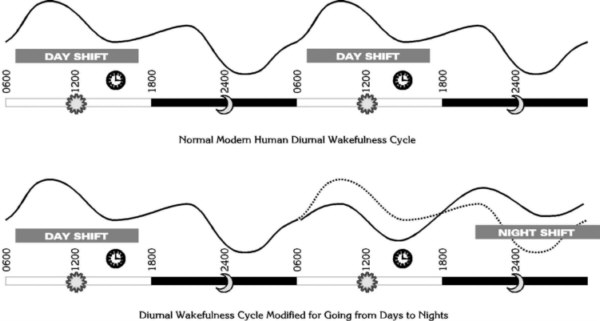
Mercy Hospital of Pittsburgh
Department of Emergency Medicine
Memorandum
March 4, 1995
To: Greg Larkin, M.D.
From: Keith Conover, M.D., Attending Staff/ Information Systems Coordinator
Subj: Schedules and Circadian Cycles
After perusing your detailed and thought-provoking memo on scheduling, I had several thoughts. One of them was, I thought, worth trying to work out and express clearly. This is not based on anything I've found in the emergency medicine literature, but is based on my own study of human biological rhythms and my own experience. Over the past few months, I seem to have been scheduled for an inordinate number of 7 AM day shifts followed by 11P-7A night shifts. And, I've found it not to be as bad as one might expect from reading the literature. And, I think there is a good reason for this. The human diurnal wakefulness cycle has a free-running periodicity of about 25 hours, but is constantly reset to a 24- hour cycle by other cues: sunlight, body heat generation and loss cycles, food and caffeine intake, and activity. Thus, the idea that stretching the cycle longer and longer is easier than compressing it shorter and shorter. True, but I think there's an easier way. The human diurnal wakefulness cycle is bimodal, with peaks in the morning and evening. This is illustrated in the top of the two attached diagrams. Note the clock that indicated the 2-3 PM siesta lull in wakefulness. We now know this will happen regardless of what one eats for lunch, or when one eats lunch; it is an integral part of our daily cycle. (In olden days, the peaks were probably earlier and even perhaps a bit more compressed, but light is such a powerful cue that I suspect that bright artifi- cial lighting has both shifted the cycles later and stretched them out a bit.) I've found that in going from 7 AM days to 11 PM nights, one can successfully make a phase shift. One keeps morning activity and eating light, and turns the afternoon siesta time into a deep sleep (nap) period. After this, one is deliberately active and then eats a big dinner. This helps keep the night-time sleepiness to a minimum, by interchanging the height of morning and evening wakefulness curves. This is illustrated in the lower diagram: the dotted line is "normal" and the solid line is the modified "night" cycle. At least for me, I find this easier than trying to "stretch" a cycle. It also makes it easier to get back to a day cycle on the day following. I suspect this may be one of the reasons I am not in favor of 6 AM days and evenings lasting until 1 AM: working these shifts, one cannot stay on a day/inverted day alternation, but must in fact "stretch" the cycle, which may take several days to get back into synch. "Anchor sleep" is a useful concept. However, I personally believe that a better metaphor for conceptualizing the sleep/wake cycle is a long narrow piece spring steel, or better yet a long flat (and slightly stretchy but incompressible) piece of rubber. This then replaces the lines on the accompanying diagram. One can push the rubber down a bit by taking a nap, one can pull it up a little bit by drinking some caffeine, but anything one does in one place affects all the cycles to the right. One cannot compress it, but one can stretch a bit, but stretch too much and it breaks into chaos. [addendum to the web version: a waterbed might make an even better analogy]
For the day to night phase shift that I suggest, one can visualize pressing down on the day part of the cycle, and in response the night part pops up a bit in response. The analogy makes it easy to sense how much easier this is than to stretch the rubber to near the breaking point. I hope you find these thoughts and this analogy useful in your cogitations on the schedule issue. Thank you.
encl: CIRADIA.DS4 (drawing)
cc: DEM Attending Staff
